

What Are The Ideal Settings for Shooting a Timelapse? Understanding the Basic Functions of a DSLR. One of the challenges you need to overcome when shooting is determining the ideal setting for your camera.
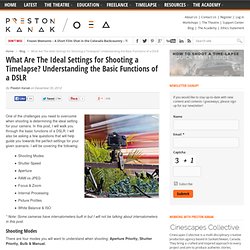
In this post, I will walk you through the basic functions of a DSLR. I will also be asking a few questions that will help guide you towards the perfect settings for your given scenario. I will be covering the following: Shooting ModesShutter SpeedApertureRAW vs JPEGFocus & ZoomInternal ProcessingPicture ProfilesWhite Balance & ISO * Note: Some cameras have intervalometers built in but I will not be talking about intervalometers in this post. Shooting Modes There are four modes you will want to understand when shooting; Aperture Priority, Shutter Priority, Bulb & Manual.
Av – Aperture Priority – Aperture priority mode allows you to set the aperture of the lens and the camera will select the correct shutter speed. Fisheye-Nikkor lenses - Main Index Page. Nikon has more than seven fisheyes lenses in total, each with varying lens speed, features, technical specifications and lens type for different kind of photographic applications.
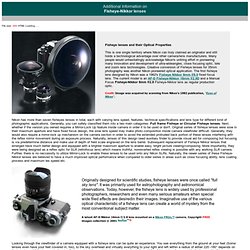
Generally, you can safely classified them into a two main catagories: Full frame Fisheye or Circular Fisheye lenses. Next, whether if the version you owned requires a Mirror-Lock Up feature inside camera in order it to be used or don't. Original series of fisheye lenses were slow in their maximum aperture and have fixed focus design, the slow lens speed may make photo composition inside camera viewfinder difficult. Generally, they would also require a mirror-lock up mechanism on the camera section in order to avoid the extended protruded back portion of these lenses interfering with the reflex mirror movement during an exposure process.
LRTimelapse - advanced Time Lapse Photography made easy! Little Bramper - bulb-ramping intervalometer for Canon dSLRs. Bulb-ramping works on Canon cameras because of the way they have implemented their Bulb mode.
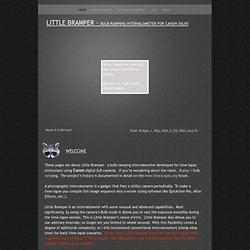
Nikon cameras have bulb modes that apparently make bulb-ramping impractical. Canon cameras with PC sockets (mid- and high-end dSLR bodies): I use it successfully on my 5D Mark 2, 40D. Known to also work on 1D Mark 4, 7D, 60D(see note), 50D, 30D. Known to work on Digital Rebels (adapters required, see below): 300D, 350D, 500D Little Bramper will fire any Canon camera with the proprietary N3 remote socket (5D Mark 2, 40D, 7D etc.) Suitability test: With your camera in Bulb mode, if you can manually (i.e. using finger) achieve exposures of 1/10s then Little Bramper will probably work well. I expect it to work on all current xxD, xD bodies. Canon cameras without PC sockets (Digital Rebels):
SYRP. Astro: Time-Lapse + Motion Control by Oscar Ramírez. REWARD #1- $1.00 or more: Access to backer-exclusive updates and your name posted on our website as a contributor.
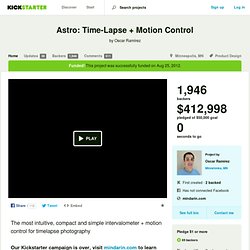
REWARD # 2: $15.00 or more: Access to backer-exclusive updates, your name posted on our website as a contributor, and one short guide book for timelapse photography with tips, settings and checklists. REWARD # 3: $30.00: Access to backer-exclusive updates, your name posted on our website as a contributor, and your spot on the second production run of Astro at the Kickstarter price! Your pledge will be an advanced payment for when you place the order in early 2013. REWARD # 4: $160.00 or more: (silver Astro) Access to backer-exclusive updates, your name posted on our website as a contributor, one short guide book for timelapse photography with tips, settings and checklists. One camera cable. Star Lapse Tips - ABC Open. Have you ever had so much passion to learn something you just ended up teaching yourself?
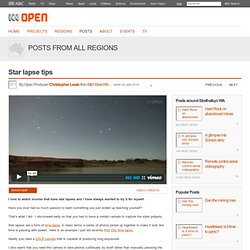
That’s what I did - I discovered early on that you had to have a certain camera to capture the stars properly. Star lapses are a form of time lapse, in basic terms a series of photos joined up together to make it look like time is passing with speed. Here is an example I just did recently Port City time lapse. Ideally you need a DSLR camera that is capable of producing long exposures. I also learnt that you need the camera to take photos continually by itself rather than manually pressing the button for every photo.
Some cameras have built in self-timers that are capable of programming the timing for each photo. How Do You To Create A Timelapse Of The Night Sky - ABC Open. Inspired by a star-lapse tips blog by Chris Lewis, and stunning time lapse sequences like Mauna Lapse: From Sea to Summit.
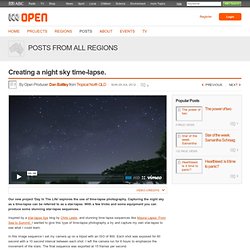
I wanted to give this type of time-lapse photography a try and capture my own star-lapse to see what I could learn. In this image sequence I set my camera up on a tripod with an ISO of 800. Each shot was exposed for 60 second with a 10 second interval between each shot. I left the camera run for 6 hours to emphasize the movement of the stars. The final sequence was exported at 15 frames per second. See the comparison between 15 frames per second and 25 frames per second here. Night Sky Photo Tips. Nikon D800 Night Time Lapse Tutorial. Testing low light perfomance with D800 and 5D3.
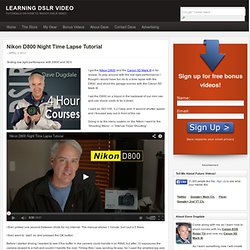
I got the Nikon D800 and the Canon 5D Mark III in for review. To play around with the low light performance I thought I would have fun do to a time lapse with the D800, and shoot the garage scenes with the Canon 5D Mark III. I set the D800 on a tripod in the backseat of our mini van and use shock cords to tie it down. I used an ISO 100, 3.2 f-stop and .4 second shutter speed and I focused way out in front of the car.
Going in to the menu system on the Nikon I went to the ‘Shooting Menu’ -> ‘Interval Timer Shooting’. I then picked one second between shots for my interval. I then went to ‘start’ on and pressed the OK button. Before I started driving I wanted to see if the buffer in the camera could handle it on RAW, but after 10 exposures the camera slowed to a halt and couldn’t handle the over 70meg files I was sending its way. Many ways to do this but one of my favorite is to use After Effects to process the images. After Effects Procedure. 6 Timelapse Photography Tips [You May Not Have Considered]
A Guest Post by Clayton McLaughlin There are a lot of tutorials out there that introduce the practice of shooting timelapses with a variety of different cameras. All of which can help you get started. But as with any situation, I’ve found there are a few things that have helped me along the way that I never read in a tutorial online. 1. Use velcro to secure the wireless trigger Using a remote trigger does two things that are important to timelapse photography. My solution. 2. Homepage of Michael Theusner - Time-lapse Photography - Step-by-Step. Here is what you have to do to prepare your equipment for a successful run: Find a suitable spot for your time-lapse movie.
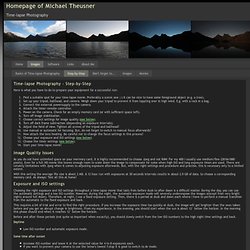
Preferably a scenic one ;-) It can be nice to have some foreground object (e.g. a tree). Set up your tripod, ballhead, and camera. Weigh down your tripod to prevent it from toppling over in high wind. 17 Steps to Create Time Lapse Video from Still Images. 17 Steps to Create Time Lapse Video from Still Images Watch this photography tutorial to learn how to make a time-lapse video with your DSLR camera.

Wish you could take gorgeous photos? Now you can! See our Review of a New Educational Resource – Tools and Techniques for Creative Photography – eBook On January 11th and 12th Connecticut was hit with a blizzard that dropped 20-30 inches of snow across the state. How Do You To Create A Timelapse Of The Night Sky - ABC Open. The Ultimate Guide to Time-Lapse Photography. Boy, are we excited.

We’ve spent every waking moment these last months cooped up in the Photojojo Labs, working tirelessly on what can only be our greatest experiment ever. We’ve finally done it. We’ve found the key to… Time Travel. Timelapse Photography Tutorial: An Overview of Shooting, Processing and Rendering Timelapse Movies. You’ve probably stumbled upon an incredible work of time-lapse where you just couldn’t get the images and the feelings out of your head. Possibly you are fascinated by nature and the slow changes that occur over a period of time. A flower blooming, a sunset or a moonrise. Maybe it was a construction project or a cityscape at night, full of activity and production. Save 20%: Time-lapse Photography eBook. Note: This deal is expired; however, you can visit the website directly to check out their latest deals. Up for grabs in this SnapnDeal is a complete introduction to shooting, processing and rendering time-lapse movies with a DSLR camera.
The guide covers the art and science of time-lapse photography and contains both detailed explanations and immediately actionable summaries in a colorful easy to understand and fun to read package. It will also walk through three separate rendering workflows that touch different ends of the cost (both free and not so free), functionality and time-to-learn spectrum. Click here to view more details … or watch this great introduction from the eBooks author, Ryan Chylinski. Slowing Down Time With Time-Lapse Photography. Digital Tools Teaching Strategies Ken Murphy. Time Lapse Tutorial – BBC Human Planet. Tips and techniques One lump or two? Update: If you have questions about time lapse please contact me via my new Facebook page or join a photography workshop HERE.
Time lapse photography can be a lovely way to spend a quiet afternoon somewhere. Whilst others might go fishing, I prefer settling down with a flask of tea and my tripod, giving myself the time to really appreciate the environment I find myself in. A Beginner's Resource for Altered Time Perception Cinematography. Digital Timelapse Discussion - Index page.